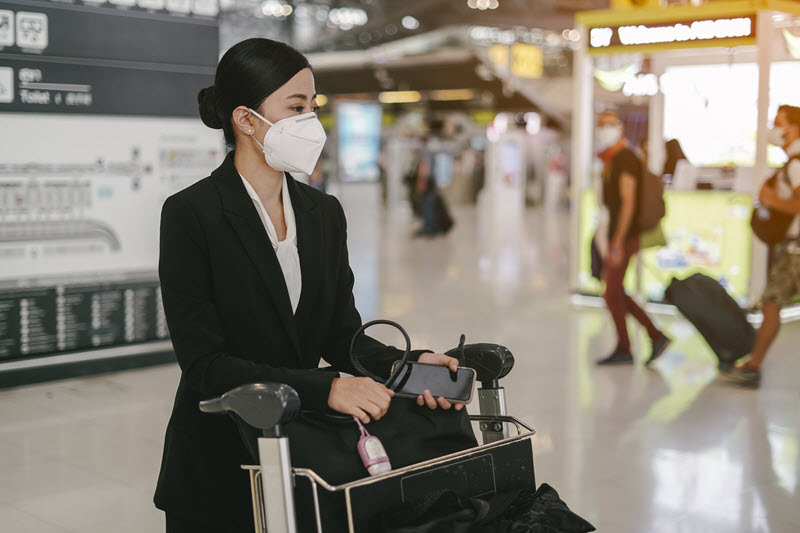by Isaac Benzaquen, Dave DeSanto, Stephen Rumpler & Jerry Schwinghammer
Airports remain a key and resilient infrastructure for our society even amid the COVID-19 pandemic that has caused an unprecedented effect on the air travel and commerce industry. Reductions of as much as 90% fewer travelers are putting tremendous pressure on airports to survive and establish a new normal.
Two primary challenges present themselves:
First, how will airports restore passenger confidence given travel is such a critical factor to powering the economy? This is the topic of focus for this blog post.
Second, what infrastructure changes will be required to implement health and safety measures to protect the flying public and airport workforces? We will focus on this item in a future post.
“The safety, security and health of passengers and staff remain top priorities for airports and their partners in the aviation industry” Angela Gittens of Airports Council International (ACI) World

Regarding passenger confidence, airports need to address the following questions:
- What measures can we take to increase passenger confidence?
- How can we communicate changes to passengers (e.g. cleaning cycles and procedures) to enhance their comfort?
- How can we constantly gain feedback from passengers and manage the airport’s performance metrics?
- How can we fold our concept testing into an operational tool?
Fortunately, the focus for airports has not changed. They will continue to power citizen’s journeys and serve as key enablers to kick start the economy. However, greater flexibility, adaptability, and innovation are paramount. Swift decision-making and stakeholder collaboration are becoming crucial factors for effective change and building confidence. Looking to the future, airports must assess their overall experience and rethink their operational models. It is not a question of ‘If’ the unexpected will happen, but rather ‘When will it happen?’, ‘What will happen?’, and ‘Are we prepared?’ Airports need to better define their operational processes to effectively conduct “What If” analysis as well as resume operational responsibilities if large numbers of staff become incapacitated. Thankfully, there are technologies that can be leveraged for airports to more effectively respond than post-2001 (9/11) or in 2008 (The Great Recession).
Enter the Virtual Twin, which breathes life into process documentation, visualization, and training using a business platform approach. In basic terms, this means to build a functional, digital replica of an existing airport and all its assets and processes. Airports should now be evaluating the development of a Virtual Twin to ensure business continuity and provide financial, operational, and customer experience benefits. Embracing this new Virtual Twin technology will enable airports to achieve their innovation and collaboration goals while keeping passengers safe, healthy, and secure.

Using the Virtual Twin’s simulation capabilities, airport teams can perform virtual testing to combat situations like the COVID-19 pandemic with use cases, such as validating the efficiency and effectiveness of open ventilators. The Virtual Twin also could simulate the propagation and exposures of the virus to highlight potential cross-infection areas in the airport and related impacts on passengers and their surroundings.
“It is very important that all actions taken by the airport to keep passenger safe, is communicated in affiance manner.” Angela Gittens of Airports Council International (ACI) World
One advantage of a Virtual Twin is that its content can be displayed in Augmented and Virtual Reality (AR/VR). Airports can take advantage of this to create a simple and enjoyable experience to communicate their initiatives that provide a safe and healthy environment for passengers, such as cleaning procedures, frequency, and intensity. This also allows passengers to get a taste of available services and to easily find their way to restaurants, lounges and shops.
Regarding airline and airport coordination, there remains a distinct opportunity for collaboration to meet and respond to unprecedented current and future challenges. Specifically, collaboration between airports and airlines as they remain the key stakeholders involved in partnering on the overall passenger journey. Shared situational awareness and coordinated action between airline and airport stakeholders can be enabled via a Virtual Twin, knocking down siloes of systems and processes to pave a smoother future for air travel. This could include tracking potentially infected passengers and other ways to quickly and effectively respond in the event of another outbreak.
One of the most immediate requirements after COVID-19 will be the need for reconfiguration for social distancing to reassure passengers of their safety. A Virtual Twin can effectively model and simulate distancing, passenger flows, queues, etc. The visualization capability of the Virtual Twin will also allow the airport to effectively monitor physical distancing (via IoT or CCTV) and inform passengers of safe airport navigation procedures.
Ultimately, the airport can optimize its operational performance by running What-If scenarios based on simulation data and/or real data in the virtual world without impeding day-to-day operations. Imagine the power of testing your vision for tomorrow’s airport in the virtual world today.
In conclusion, Virtual Twin technology can transform how an airport could prepare for, alleviate, and recover from a crisis, whether a pandemic or other extraordinary event. As massive drivers of economic activity for each of their respective regions, it is critical that airports leverage all means necessary to create a safe and healthy environment for their passengers so they are comfortable traveling again.
Visit our website to find out how the 3DEXPERIENCE platform can help airports use digital twins to redefine the passenger experience.

Isaac Benzaquen is the Global Airport Industry Solution Director at Dassault Systèmes. With more than 33 years of experience within the industry, Isaac is constantly looking at delivering innovative solutions to solve customer challenges.

Dave DeSanto recently retired following a 21-year career at Dallas-Fort Worth International Airport (DFW) as a Senior Manager for Engineering Applications as part of the Information Technology and Infrastructure Development departments. Prior to DFW, he spend 20 years as a Civil Design and GIS practitioner. Dave has more than 40 years of leadership experience on strategic planning and application systems management for planning, design, construction, and operations of asset lifecycle management solutions.

Stephen Rumpler is a Client Executive for Dassault Systèmes supporting Airlines and Airports in North America. He has spent 14+ years enabling his clients success via innovative technology solutions within the Travel Industry. As a trusted advisor to his clients, he is constantly striving to meet the strategic objectives of his customers around revenue generation, cost containment, and enhanced customer experience initiatives.

Jerry Schwinghammer is DXC‘s Associate Partner for Airport Consulting. He was formerly the CTO at Charlotte Douglas International Airport, and a Technology Manager at Orlando International Airport. Jerry has more than 25 years of leadership experience on strategic planning and organizational transformation for major transportation infrastructure enterprises as well as private business operations.

